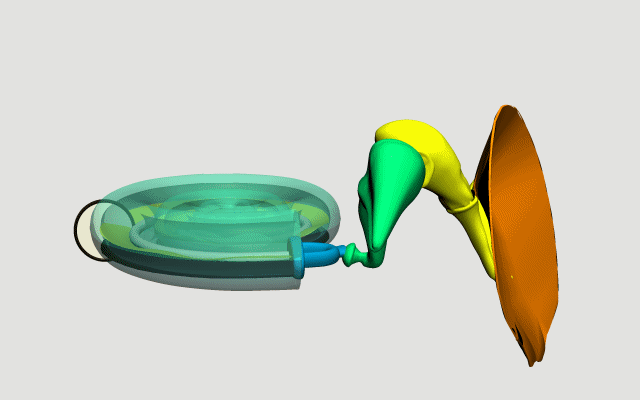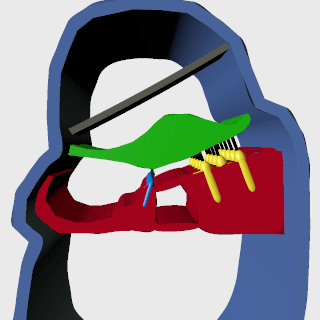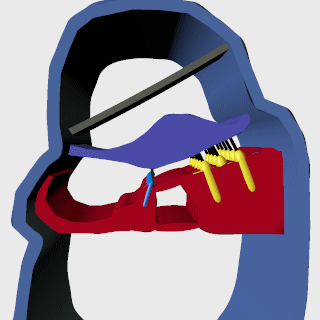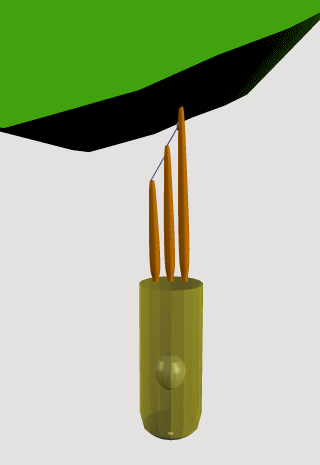Friday, January 18, 2019
I dare you.
The more you know about REAL science, the more you MUST believe in design.
The cochlea is an indisputable manifesto for design. Every detail of its basic shape, mass, stiffness, size, and unspeakably complex mechanism is finely tuned for the best possible static and dynamic performance.
Now another piece of understanding packs more weight onto the manifesto.
Via ScienceDaily, a closeup look at the dynamic performance of the tectorial membrane shows a nanostructure that behaves differently at different frequencies. It helps to emphasize frequencies in the speech range and de-emphasize nonspeech frequencies.
 First a cross-section showing the tectorial membrane acting like a solid (green) at higher frequencies. Each of the outer hair cells (yellow) pokes into the tectorial surface, and the tectorial surface moves the hair back and forth rigidly.
First a cross-section showing the tectorial membrane acting like a solid (green) at higher frequencies. Each of the outer hair cells (yellow) pokes into the tectorial surface, and the tectorial surface moves the hair back and forth rigidly.
 Now a cross-section showing the tectorial membrane acting more squishy or gelly (blue) at medium speech-range frequencies. Each outer hair cell is driven fluidly, allowing it to slip back and forth and resonate more freely.
Now a cross-section showing the tectorial membrane acting more squishy or gelly (blue) at medium speech-range frequencies. Each outer hair cell is driven fluidly, allowing it to slip back and forth and resonate more freely.
 = = = = =
Note that each OHC has a fantastic inner mechanism (not part of this research) that strengthens its own response when a frequency is unfamiliar.
Overall, the cochlea separates frequencies by place, thanks to the gradients of stiffness and mass and size. Hair cells nearest the input respond to lower frequencies, and hair cells toward the small tight center of the spiral respond to higher frequencies.
= = = = =
Note that each OHC has a fantastic inner mechanism (not part of this research) that strengthens its own response when a frequency is unfamiliar.
Overall, the cochlea separates frequencies by place, thanks to the gradients of stiffness and mass and size. Hair cells nearest the input respond to lower frequencies, and hair cells toward the small tight center of the spiral respond to higher frequencies.
 This tip-link mechanism helps with adaptation to steady sounds. The longest hair is driven directly by the tectorial membrane, and the shorter hairs are controlled by the tip-link. When a signal at this hair's preferred frequency is new, the tip-links pull the secondary hairs along to emphasize the input to the cell itself. As this frequency continues, the tip-links gradually slide out of the little gate in the longer hair, so the secondary hairs are no longer joining in. After this signal stops, the longer hair reels in and tightens up the tip-link so it can emphasize the next new appearance of its preferred frequency.
I dare you to figure out how this mechanism arose "randomly" through mutation. Just try.
= = = = =
Later pure speculation and stupid guessing: The gel action would seem unnecessary, since each OHC is already narrowly focused on one frequency by the basic structure of the cochlea. I wonder if the gelness is externally modulated? Gelness depends on hydration. When the cochlea is getting less water overall, speech frequencies are less emphasized, so you're more responsive to ambient sounds. Survival mode? Or is the hydration controlled intentionally by other parts of the nervous system for other purposes?
This tip-link mechanism helps with adaptation to steady sounds. The longest hair is driven directly by the tectorial membrane, and the shorter hairs are controlled by the tip-link. When a signal at this hair's preferred frequency is new, the tip-links pull the secondary hairs along to emphasize the input to the cell itself. As this frequency continues, the tip-links gradually slide out of the little gate in the longer hair, so the secondary hairs are no longer joining in. After this signal stops, the longer hair reels in and tightens up the tip-link so it can emphasize the next new appearance of its preferred frequency.
I dare you to figure out how this mechanism arose "randomly" through mutation. Just try.
= = = = =
Later pure speculation and stupid guessing: The gel action would seem unnecessary, since each OHC is already narrowly focused on one frequency by the basic structure of the cochlea. I wonder if the gelness is externally modulated? Gelness depends on hydration. When the cochlea is getting less water overall, speech frequencies are less emphasized, so you're more responsive to ambient sounds. Survival mode? Or is the hydration controlled intentionally by other parts of the nervous system for other purposes?
The researchers found that the tectorial membrane's structure "looked like a solid but behaved like a liquid," Freeman says -- which makes sense since it is composed mostly of liquid. "What we're finding is that the tectorial membrane is less solid than we thought." The key finding, which he says the team hadn't anticipated, was that "for middle frequencies, the structure moves as a liquid, but for high and low frequencies, it only behaves as a solid."= = = = = Here's an overview of the cochlea driven by the eardrum through the three ossicle bones. The circle on left indicates the location of the cross-section in the next two animations.
 First a cross-section showing the tectorial membrane acting like a solid (green) at higher frequencies. Each of the outer hair cells (yellow) pokes into the tectorial surface, and the tectorial surface moves the hair back and forth rigidly.
First a cross-section showing the tectorial membrane acting like a solid (green) at higher frequencies. Each of the outer hair cells (yellow) pokes into the tectorial surface, and the tectorial surface moves the hair back and forth rigidly.
 Now a cross-section showing the tectorial membrane acting more squishy or gelly (blue) at medium speech-range frequencies. Each outer hair cell is driven fluidly, allowing it to slip back and forth and resonate more freely.
Now a cross-section showing the tectorial membrane acting more squishy or gelly (blue) at medium speech-range frequencies. Each outer hair cell is driven fluidly, allowing it to slip back and forth and resonate more freely.
 = = = = =
Note that each OHC has a fantastic inner mechanism (not part of this research) that strengthens its own response when a frequency is unfamiliar.
Overall, the cochlea separates frequencies by place, thanks to the gradients of stiffness and mass and size. Hair cells nearest the input respond to lower frequencies, and hair cells toward the small tight center of the spiral respond to higher frequencies.
= = = = =
Note that each OHC has a fantastic inner mechanism (not part of this research) that strengthens its own response when a frequency is unfamiliar.
Overall, the cochlea separates frequencies by place, thanks to the gradients of stiffness and mass and size. Hair cells nearest the input respond to lower frequencies, and hair cells toward the small tight center of the spiral respond to higher frequencies.
 This tip-link mechanism helps with adaptation to steady sounds. The longest hair is driven directly by the tectorial membrane, and the shorter hairs are controlled by the tip-link. When a signal at this hair's preferred frequency is new, the tip-links pull the secondary hairs along to emphasize the input to the cell itself. As this frequency continues, the tip-links gradually slide out of the little gate in the longer hair, so the secondary hairs are no longer joining in. After this signal stops, the longer hair reels in and tightens up the tip-link so it can emphasize the next new appearance of its preferred frequency.
I dare you to figure out how this mechanism arose "randomly" through mutation. Just try.
= = = = =
Later pure speculation and stupid guessing: The gel action would seem unnecessary, since each OHC is already narrowly focused on one frequency by the basic structure of the cochlea. I wonder if the gelness is externally modulated? Gelness depends on hydration. When the cochlea is getting less water overall, speech frequencies are less emphasized, so you're more responsive to ambient sounds. Survival mode? Or is the hydration controlled intentionally by other parts of the nervous system for other purposes?
This tip-link mechanism helps with adaptation to steady sounds. The longest hair is driven directly by the tectorial membrane, and the shorter hairs are controlled by the tip-link. When a signal at this hair's preferred frequency is new, the tip-links pull the secondary hairs along to emphasize the input to the cell itself. As this frequency continues, the tip-links gradually slide out of the little gate in the longer hair, so the secondary hairs are no longer joining in. After this signal stops, the longer hair reels in and tightens up the tip-link so it can emphasize the next new appearance of its preferred frequency.
I dare you to figure out how this mechanism arose "randomly" through mutation. Just try.
= = = = =
Later pure speculation and stupid guessing: The gel action would seem unnecessary, since each OHC is already narrowly focused on one frequency by the basic structure of the cochlea. I wonder if the gelness is externally modulated? Gelness depends on hydration. When the cochlea is getting less water overall, speech frequencies are less emphasized, so you're more responsive to ambient sounds. Survival mode? Or is the hydration controlled intentionally by other parts of the nervous system for other purposes?Labels: Grand Blueprint
